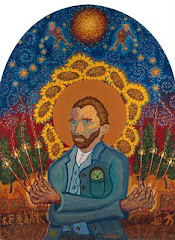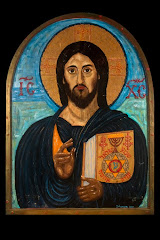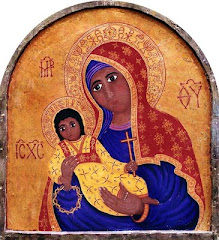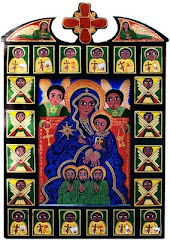When Jesus Came the Corn Mother’s Went Away
(a post-new-historicist prose-poem by Daniel Imburgia)
"Something has not yet arrived, neither at Christianity nor by means of Christianity. What has not yet arrived at or happened to Christianity is Christianity. Christianity has not yet come to Christianity." (Jaques Derrida, "The Gift of Death." pg.29)
The original Madonna of the Wheat fields, the one I used as a model for my painting, “Madonna of the Corn Fields” above, is a fusioned depiction of The Virgin Mary created in Northern Europe by an unknown artist in the 15th century that I saw and remembered on one of my travels. Her long flaxen hair, gold blouse, and white skin were set against, but also had much correspondence with the background of a harvest yellow wheat field and treeless horizon. She is probably an amalgam of the Germanic goddess Fulla or maybe Hariasa and the Virgin Mary. Such amalgamations are routinely condemned but I think these spiritual miscegenations and the power relations among colonizers and indigenous are often more complex than many more simplistic narratives account for.
One notices though that she is not called the ‘Maddona of the Sacred Forest,’ or ‘The virgin of the Holy Tree’ perhaps because the wounds of the bloody struggle of Christianity against the Norse pagans and their demonic rituals at ‘sacred groves,’ and their idolatrous ‘tree worshipping’ were still too raw. In any event, a compromise allowing the adornment of yule trees into the home once a year coupled up with the birth of the God-man Jesus was worked out and since World War II the Norse pagans, for the time being, seem to be peacefully accepting this arrangement.
Perhaps the greatest account of these recurring myth’s about sacred trees is the one about Yggdrasil. She was an enormous tree located in what they of course called the ‘center of the world,’ she was really thought of as a “World Tree,” as it was sometimes referred to in their worship. One can read about this extraordinary tree in a long prophetic poem called the “Poetic Edda.” Here is just a sampling:
Hearing I ask, from the holy races,
From Heimdall's sons, both high and low;
Thou wilt, Valfather, that well relate
Old tales remember, of men long ago.
From Heimdall's sons, both high and low;
Thou wilt, Valfather, that well relate
Old tales remember, of men long ago.
I remember yet, the giants of yore,
Who gave me bread, in the days gone by;
Nine worlds I knew, the nine in the tree
With mighty roots, beneath the mold...
Who gave me bread, in the days gone by;
Nine worlds I knew, the nine in the tree
With mighty roots, beneath the mold...
An ash I know, Yggdrasil its name,
With water white, is the great tree wet;
Thence come the dews, that fall in the dales,
Green by Urth's well, does it ever grow.
With water white, is the great tree wet;
Thence come the dews, that fall in the dales,
Green by Urth's well, does it ever grow.
On all sides saw I, Valkyries assemble,
Ready to ride, to the ranks of the gods;
Skuld bore the shield, | and Skogul rode next,
Guth, Hild, Gondul, and Geirskogul.
Of Herjan's maidens, the list have ye heard,
Valkyries ready, to ride o'er the earth.
Ready to ride, to the ranks of the gods;
Skuld bore the shield, | and Skogul rode next,
Guth, Hild, Gondul, and Geirskogul.
Of Herjan's maidens, the list have ye heard,
Valkyries ready, to ride o'er the earth.
I saw for Baldr, the bleeding god,
The son of Othin, his destiny set:
The son of Othin, his destiny set:
Hard is it on earth, | with mighty whoredom;
Axe-time, sword-time, shields are sundered,
Wind-time, wolf-time, ere the world falls;
Nor ever shall men, each other spare.
Axe-time, sword-time, shields are sundered,
Wind-time, wolf-time, ere the world falls;
Nor ever shall men, each other spare.
Fast move the sons, of Mim, and fate
Is heard in the note, of the Gjallarhorn;
Loud blows Heimdall, the horn is aloft,
In fear quake all, who on Hel-roads are.
Is heard in the note, of the Gjallarhorn;
Loud blows Heimdall, the horn is aloft,
In fear quake all, who on Hel-roads are.
Yggdrasil shakes, | and shiver on high
The ancient limbs, | and the giant is loose;
To the head of Mim, does Othin give heed,
But the kinsman of Surt, shall slay him soon.
The ancient limbs, | and the giant is loose;
To the head of Mim, does Othin give heed,
But the kinsman of Surt, shall slay him soon.
And on it goes for 150 pages or so. Let me give you the short version as I understand it from the Voluspo in the Codex Regius: Top god Othin to avoid the destruction of the world calls Volva the wise woman from the grave who recounts the creation of the world and all the various peoples, dwarves, wanes, the first man and women, etc., and she also cleverly reveals how much smarter and wiser she is than Othin by reading his thoughts and then revealing a prophecy about the final battle and destruction of the gods and the world itself in flood and fire. Pretty standard mythological stuff all in all. Then it recounts how all nine of the gods meet under the great tree “Yggdrasil,” the “World Tree” this mediator between earth and heaven to work out how to save the cosmos. Skipping ahead we meet the Valkyries who bring heroically slain warriors back to Othin to continue to wage the battle. But Othin is killed just the same and so is the bleeding boy-god Baldr and yadda yadda eventually a new and beautiful world rises on the ruins of the old. Anyone who has watched the movies Avatar, Gladiator, Lord of the Rings and seen Wagner’s Goterdammerung (or at least Francis Ford Coppola’s Apocalypse Now) will understand the gist of Norse myth, and some of Christian myth-making as well.
Of course what was missing in the movie Avatar was the on-board chaplain and the blessing of the gun-ships etc.. Although, in 2153 as today, the Chaplin would probably not be a Franciscan friar but an Evangelical/falangist/NRA lieutenant hired by the RDA corporation to provide spiritual guidance to the soldiers and the ship’s crew and assure them that their real mission on Pandora was to save the souls of the tree worshipping Na’vi for Jesus. And if a bit of unobtainium or low sulphur crude oil finds it’s way back to the mother country, well, where’s the harm in that?
Coincidentally, the Poetic Edda leaves off just about the time Saint Boniface, the “Apostle to the Germans” shows up in Germania with his axe and his bible! Boniface made many evangelizing trips to Germania but what he is most remembered for is when he laid his axe to the base of the great oak called “Jove’s Tree” or (Jupiter’s or Donar’s Tree) and with one stroke and some divine intervention the greatest and most sacred tree in Europe came crashing down in the year 754. The pagan witnesses who had been counting on their war-god who sometimes dwelled in the tree to help them kill and drive away the Christian invaders lost all heart and hope and mostly converted en masse to Christianity. The wood was not altogether wasted however, it was sawed up and used to construct a church to commemorate the victory of Jesus over Jupiter! Oh for sure there were a few enraged holdouts against this ‘blasphemy,’ just like there are still some Lakota who are still angry about their most sacred mountain defiled and desecrated by having the gigantic faces of four american president’s of the united states carved into it, and who unblinkingly glare down and remind the natives of their subjugation and oppression. But for the most part the Germans fell into line and started killing in the name of Jesus instead of Thor or Odin or Jupiter, and the borders of civilization and the light of christianity advanced a few more leagues into the dark forests of sin and ignorance (*note, a few of those disgruntled pagans caught up with Boniface some years later and like at the battle of the Little Big Horn at Custer’s last stand, Boniface and 52 monks were killed, that is, “martyred in retaliation for murdering Yggdrasil ).
Now I confess to my devotion to the Mother of God, Virgin Mary, the “Theotokos” or “God-bearer,” and as a Christian I pray to her often. I know this mystifies many of my protestant brothers and sisters (and some family members too LoL). I suspect some of them see me no differently than some tree worshiping Norse pagan and would gleefully take an apocalyptic axe to the root of all my Popish superstitions. I used to discuss this with my wife Lynda’s adopted grandmother Lydia Haas on the Pine Ridge indian reservation when we would visit (she died a year ago at 96 years of age!). She was very understanding because she too had creatively blended her Catholicism, the wisdom of her Lakota religious traditions, and even a bit of protestant evangelicalism into her religious cosmology. It was not unusual for us to be attending a powwow and Grandma Lydia would be praying the rosary to the beat of the drum circle and slapping time on her King James bible annotated by Jimmy Swaggert! In her long life filled with a lot of heartache and suffering she said that she would often call on Jesus, the Virgin Mary, Sister Teresa, as well as the spirit of Crazy Horse to get her through her tribulations. She had attended a severe Catholic school as a child but had also asked Jesus into her heart as her personal savior while listening to the radio around 1956, and she had later also taken a trip to Rome in 1967 with a group of 18 other Roman Catholic Lakota women and Pope Paul VI had given them all a brief private audience and blessing!
So it was in the truly ecumenical spirit of a wise Lakota Grandmother that when I decided to paint my version of the ‘Madonna of the Wheat Fields‘ I gave myself license to make some alterations. As you can see she is dressed more in the style of a Mexican or Central american woman, her hair, skin, and eyes are dark, and the baby Jesus looks less like a bastard of George Armstrong Custer and more like a child of an illegal alien being deported back to Guatemala. This painting was inspired in part after I had read the book “When Jesus Came the Corn Mother’s Went Away: Marriage, Sexuality, and Power in New Mexico, 1500-1846.” By Ramon A. Guitierrez. The book recounts the subjugation, oppression, murder, and conversion of the Pueblo Indians. But it also speaks to their ability to resist and fight back, to force accommodations, and to both subversively and overtly inject and blend some of their profound cosmology into the kind of Imperial Catholicism they encountered. And this struggle still isn’t over, not with the Pueblos or for many other tribes in north american and around the world. The stories and wisdom of colonized peoples are still being told and retold as is the story of the catastrophe of their encounter with “civilization.” There are lots of stories about the Corn Mothers and in many other tribes besides the Pueblo. Here is one history recounted by Guitierrez:
“After the Corn Mothers, Iatiku and Nautsiti, had lived on the earth together for a while they began to quarrel because Nautsiti was selfish and hoarded the things in her basket. Because the sisters constantly argued, Nautsiti decided to leave her sister, taking with her the child she loved and her basket which contained sheep and cattle, wheat and vegetable seeds many metal things and something written. Nautsiti offered to share these things with her sister but Iatiku refused to accept them saying that she “did not want her children to have them.” So Nautsiti departed to the east and promised Iatiku that “in a long time to come we shall meet again and you will be wearing clothes.” A women bearing a likeness to Nautsiti returned to the Puelbos in 1692, just as she said she would Her name was Nuestra Semora del Rosari, La Conquistadora, (Mary Our Lady of the Rosary, Virgin of the Conquest). In one arm she carried her infant son, Jesus Christ, and in the other she carried a rosary. Around her were the things she had brought: Cattle, sheep, vegetables, metal tools, armaments, and writings. Our Lady of Conquest returned to New Mexico on August 21,1692 carried by 60 Spanish soldiers led by Don Diego de Vargas, the reconquerer of New Mexicoas.” (pg 143)
Grandma Lydia had many paintings and statues of the Holy Mother in her apartment, more of her than of Jesus if one were tabulating up that sort of thing, and all of them were as white-skinned and blue eyed (and some were even as blond as) any of the Norse goddesses! Which bugged the crap out of me with all that post-colonial and sub-altern theory under my belt but it didn’t seem to bother her in the least. It was under the supervision of these Nordic Virgin's, and several of Lydia's neighbor women friends who were even older than Lydia, that she cut and sewed by hand for my wife Lynda a complete set of Lakota women’s regalia. It is made from smoked deer hide, glass beads and porcupine quills, etc.. It was a long process and it took them all more than a year. The bead work and sewing would be accompanied by prayers to Jesus and the Virgin Mother as well as to the White Buffalo Calf Woman and God only knows who else! It is probably the most sacred and valuable thing that we own. The picture above was taken 2 years ago by brother Christian Amondson at a powwow in Oregon. It is of my wife Lynda dressed in that regalia. But the only keep-sake I have left frm pine Ridge is a T-shirt from “Big Bats,” the one and only fast food restaurant at Pine Ridge, which seems to be doing it’s best to kill off as many Indians as possible by afflicting them with diabetes. Oh, and I guess that I also have this poem I started back in 2004 at our last visit to see grandmother Lydia. And shortly afterwords Jesus came to take her home and Grandmother Lydia was waiting for him with faith and joy in her heart. But all too often in history a very different Jesus has invaded the lives of indigenous cultures and peoples, and it is that Jesus that Gutierrez records a Pueblo woman lamenting, “when Jesus came the Corn Mothers went away,” and it is that Jesus that this poem is about.
In the Ending Was the Word
When Jesus came the Corn Mothers went away
When Jesus came the people learned to flee in terror
When Jesus came many people were captured and made slaves
When Jesus came Grandmothers were insulted and abused
When Jesus came all the women were forced to wear strange clothes
When Jesus came local women healers were executed as witches
When Jesus came his followers stole all the skins from all the animals
When Jesus came our hunters were made to dig in the barren ground
When Jesus came they burned our village to build an oil pipeline through it
When Jesus came our children were taken and sent away to schools
When Jesus came his ministers and soldiers raped our children
When Jesus came the sacred dwelling places of our Gods were torn down
When Jesus came his soldiers made us worship him at gunpoint
When Jesus came we were forced into prisons, camps, and reservations
When Jesus came we were made sick with diseases that we could not cure
When Jesus came they damned up the rivers and flooded our homes
When Jesus came the waters were polluted and made undrinkable
When Jesus came they would dig away our sacred mountains to find gold
When Jesus came we could not see the stars at night anymore
When Jesus came Earth became void and darkness again covered the deep
The coming of this un-named horror was sometimes spoken of as
The great and awful apocalyptic hurricane of history
All the peoples of the world are caught up in it’s fiery vortex
All their monuments, temples and holy gathering places
Every fruit vine and seed bearing plant that is good and
Even the oldest of the grand-father trees are
Uprooted and flung up into the dark funnel
The rivers are stopped up, swallowed up, and run dry
The great waters are despoiled of life and made unlivable
Brother and sister creatures are swooped up and slaughtered
The great fishes of the sea, the swarms of flying birds
Even the dead are violently snatched from the earth and
Caught up into this desecrating storm
The words and sacred songs of the people become unspeakable
Unheard among the thunderous crushing winds
Exchanged for screeching gutterations of metals and money
No one people can stand alone against the power of this storm
All peoples are taken up and later cast down in strange places
Among unfamiliar lands without homes or sense of direction
And when those lost and struck down people gather together
They ask each other from where did this death-storm come?
And they asked each other what we should name this death-storm?
For none of the peoples had a word for such an alien destructive power
So they were forced to find a word among the language of the destroyers
And the word that they discovered was:
“Christianization”















Thanks Dan. Salem woke up at 4:30 this morning and would not go back to sleep. I am a little foggy but perhaps that this best for reading this piece.
ReplyDelete- David D
I find most of what I write is best read when ‘foggy,’ (which is how I write it) or maybe even a bit drunk or stoned. I would avoid meth though, it takes away your patience and concentration, but on peyote I can almost seem to be as wise as the Yaqui Shaman Don Juan Matus! Blessings David and obliged.
ReplyDelete